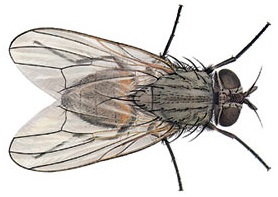

House Flies
fly types, pest control, best fly traps, how to get rid of flies


fly types, pest control, best fly traps, how to get rid of flies
The housefly, or Musca domestica, is a fly that is among the most common of all flies in the world. It is said that houseflies account for nine out of every ten flies that inhabit the homes and other buildings that are used by humans. They can be found throughout the world and have been known to carry and spread disease. They are considered to be pests, and often times exterminators will need to be called in order to deal with a large infestation of houseflies within a home.
Typically, a housefly will have a torso that is around 10 millimeters in length. The whole of the body will be covered in small hairs that are used to help them maintain flight and also provide them with information regarding their surroundings while they fly. They are also known for their large, red eyes, which can range between eight and twenty milligrams depending on the conditions surrounding the housefly.

Unlike other species of flies, the housefly only has one set of wings that is accompanied by a subset of wings. Their main wings are used to help them fly, but they do have an underdeveloped set of hind wigs that are connected just under the main wings that is used to help them maintain stability while they fly.
Houseflies are nothing to be passive about. The average female housefly can lay as many as 500 eggs over the course of a number of egg laying sessions. These will be quite hard to spot, as they are just over a millimeter in length. Maggots will hatch within 24 hours of being laid, and the maggots will seek out organic material in order to sustain themselves.
Typically, houseflies are known for eating feces, but will also feed on rotten food and flesh. They are only able to eat food in liquid form, and before feeding they must first spit their acidic saliva onto solid foods in order to break it down and begin the digestion process before starting to feed.
In colder climates houseflies are only able to survive in areas that are heated an inhabited by humans. They can be very hard to get rid of when you are dealing with a large scale infestation and not just a single wandering fly that has entered your residence. It is important that you always try to remove houseflies as you see them so that they do not lay eggs in your home. They are known to carry a number of different diseases that can be spread through their hairs, mouth and even feces including parasitic diseases and bacterial diseases. They have also been known to pass on viral hepatitis to humans.
Because they are so common, houseflies are often underestimated in the grand scheme of things in regards to danger to humans. They have the potential to quickly breed and infest warmer areas of the home that is rich with food for the maggots to feed upon. If you are looking to get rid of a housefly infestation, you may want to contact a local exterminator who has the proper tools and chemicals to dispose of the infestation for good.
Thousands of households suffer from stink bug infestation each year. Learn more about stink bugs.